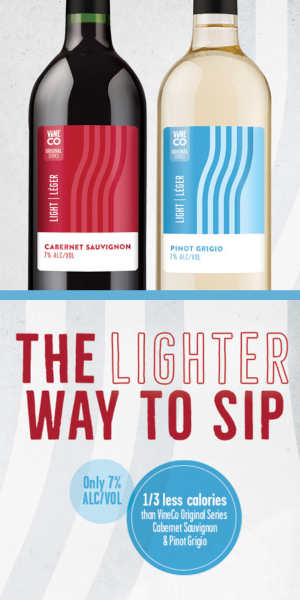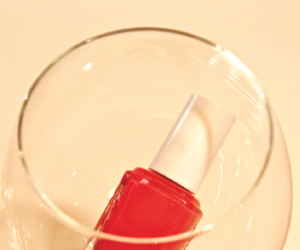Antioxidant: Compound that retards oxidation and slows its effects in wine (browning, sherry-like aromas). Sulfur dioxide, SO2, is the most widely used winemaking antioxidant. It also serves as an antimicrobial agent.
Carboy: A glass or plastic container that looks like an office water-cooler bottle or a large jug. Carboys usually come in five-gallon volumes and are used for fermenting juice, carrying out secondary fermentations, and for long-term storage.
Degrees Brix: The amount of sugar in a wine, usually measured by a hydrometer, which is a floating instrument that determines the density of solution. Based on a system calibrated to the density of water, the pre-fermentation degrees Brix of most table wines are between 22 and 24, meaning 22 to 24 percent sugar (really the percentage of total soluble solids, including unfermentable sugars). Knowing the Brix helps predict the final alcohol percentage, which should be high enough to retard growth of microbial contaminants as well as to provide sensory characteristics. For example a dessert wine (high alcohol and residual sugar) typically starts with must or juice that has 30° to 40° Brix and results in 15 to 20 percent alcohol.
Dry: No sugar left, i.e. from a chemical standpoint (the degrees Brix is approaching 0) and/or a sensory standpoint (the wine is no longer perceptibly sweet).
Enology: The science of winemaking.
Fermentation Lock: Also called airlocks, these plastic devices fit over the tops of carboys or into bung holes of barrels to allow any gas produced by wine to escape while keeping out air.
Fining: The process of adding an agent (such as bentonite or gelatin) to help clarify and stabilize the finished wine. This operation is done before bottling to help ensure the product will not be cloudy or flocculant in the bottle.
Lees: The spent yeast cells that accumulate on the bottom of winemaking vessels after the population has completed the fermentation and has died out. Wine is usually racked (siphoned) off the lees to make it more presentable and to exclude any undesirable sensory effects that extended lees contact might impart.
Maceration: The processes through which red wine grape (or other fruit) skins, seeds, and pulp are mixed and mashed in with the fermenting juice to extract tannins, colored compounds, and aroma from the grapes. Different maceration programs have different effects. For example if you stir red wine while it ferments (often called “punching down”) twice a day as opposed to once a week, you should extract more color and tannin from the skins and seeds of the grapes into the finished wine than if your strategy was less aggressive.
Malo-lactic Fermentation: Very different than alcoholic fermentation, malo-lactic fermentation occurs when a strain of lactic acid bacteria is introduced by chance or on purpose into a finished grape wine. These bacteria convert the malic acid (a natural grape acid) in the wine into lactic acid, a less potent acid, as well as contributing some flavor and aroma to the wine. Usually described as “buttery” or “caramel,” this malo-lactic aromatic profile is especially desirable in quality red wine production as well as some whites, such as Chardonnay.
Must: A red-wine making term that refers to the soupy mass of squished skins, seeds, and pulp that are fermented together. “Must” can also be applied to fruit winemaking; it refers to the gloppy pulp/skin mixture to which the yeast are added, essentially the winemaker’s raw material. In contrast if the pulp and other solids are pressed off before fermentation, the raw material is simply “juice.”
pH: The pH of a wine or juice is the measure of the number of hydrogen ions that can be detected in the solution and is a measure of a wine’s relative acidity. The pH can really only be accurately determined by titration (see Titratable Acidity).
Primary Fermentation: The first vigorous “rolling” fermentation, in which yeast convert sugar in the wine to alcohol and carbon dioxide. At this stage it is all right for the fermentation vat to be exposed to the air because the yeast are producing so much carbon dioxide that it forms a “blanket” of this inert gas over the fermenting juice or must. Once the yeast start to die down and the fermentation is less active, it’s advisable to move your wine into a carboy or barrel to exclude air and possible contaminants (see Secondary Fermenation).
Residual Sugar: Any sugar left in the wine after the fermentation is complete and the yeast have completed their life cycles and have died out. Sometimes residual sugar is desired, as in sweeter white wines or dessert wines. Residual sugar that is perceptible on the palate is seen as a defect in most red table wines.
Secondary Fermentation: A bit of a misnomer, secondary fermentation can refer to two things: 1) A true second fermentation that follows completion of the first. Usually purposely started by adding yeast and extra sugar to the finished wine to make CO2 for a sparkling wine effect. 2) The second stage of the primary fermentation. After vigorous primary, wine is transferred to a carboy or barrel (secondary fermenter) to finish the last, protracted “secondary fermentation” when the yeast are slowing down and the wine needs to be protected from oxygen and any air-borne microbial contaminants.
Sulfites: A class of sulfur-containing compounds used in winemaking as an antimicrobial agent, as an antioxidant, and as a preservative. A respiratory hazard in its undiluted state, sulfites need to be handled carefully but are entirely safe at the levels in which they are used for winemaking. If you are asthmatic and lack the enzyme sulfite oxidase, you should not consume foods or beverages that contain sulfites.
Tannin: The astringent phenolic anthocyanins found in grape skins, seeds, and stems that make your mouth pucker and feel dry when you drink red wine. Tannins are extracted from the grapes during the maceration process.
Titratable acidity (TA): Sometimes called total acidity; the total amount of acids in a wine or must that is measured by titration of the wine or juice with a base such as sodium hydroxide. Titration is metering controlled amounts of a base of known concentration into the liquid in question to chemically react with an added color-changing indicator and the acid found there. The amount of acid (expressed in grams of acid per liter of wine) will tell you roughly how acidic the wine will feel in your mouth and will allow you to acidify or de-acidify if needed.
Viticulture: The science of grape growing.
Volatile Acidity: Acid created during fermentation by spoilage organisms that are introduced by contact with fruitflies or other air-borne insects and contaminants. Refers usually to acetic acid (vinegar) produced by contamination by acetobacter bacteria. Keep fermenting wine covered to avoid problems.
Yeast Food (or Yeast Nutrient): A pre-calculated commercial mix of vitamins, minerals, and amino acids added to juice or must to ensure a clean, complete fermentation. Adding it to non-grape wines is essential because many fruits lack high enough nitrogen levels to support healthy yeast growth.






